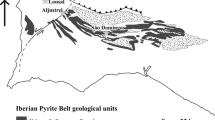Abstract
Ore-bearing rocks and natural waters of the Pitkäranta ore district (near the “Arsenic” shaft, the Hopunvaara mine field) were sampled and analyzed. The permanganate value as well as iron and manganese contents in surface water are higher than MPC values, while water samples from the “Arsenic” shaft have the elevated contents of zinc, copper, and arsenic. The Fe, Mn, Cu, Zn, Cr, As, and Ni speciation in waters have been determined by thermodynamic calculations, taking into account the possibility of the formation of metal complexes with humic and fulvic acids. The fulvic acid is almost completely consumed for the formation of the complex Fe(OH)2Fu-. Ni, Cd, Co occur mainly in the ionic form, and the fraction of Mn and Zn in the ionic form is also significant.


Similar content being viewed by others
REFERENCES
M. I. Dinu, “Interaction between metal ions in waters with humic acids in gley–podzolic soils,” Geochem. Int. 53(3), 265–276 (2015).
R. Ernst, H. E. Allen, and K. H. Mancy, “Characteristic of trace metal species and measurements of trace metal stability constants by electrochemical techniques,” Water Res., No. 6, 969–979 (1975).
V. I. Ivashchenko and A. I. Golubev, “New asecpects in the mineralogy and metallogeny of the Pitkäranta ore district,” Tr. Kar. Nauchn. Ts. Ross. Akad. Nauk, No. 7, 127–148 (2015).
I. Y. Koshcheeva, S. D. Khushvakhtova, V. V. Levinskii, V. N. Danilova, and Y. V. Kholin, “Interaction of Cr(III) with the humus acids of soil, water, and bottom sediments,” Geochem. Int. 45 (2), 178–184 (2007).
S. R. Krainov, Yu. V. Shvarov, D. V. Grichuk, E. V. Dobrovol’skii, G. A. Solomin, M. V. Borisov, B. N. Ryzhenko, L. I. Matveeva, V. I. Lyal’ko, and V. M. Shvets, Methods of geochemical Modeling and Prediction in Hydrogeology (Nedra, Moscow, 1988) [in Russian].
V. V. Krasintseva, D. V. Grichuk, G. I. Romanova, and A. I. Kadukin, “Migration and speciation of elements in pore waters of bottom sediments in the Ivan’kovskoe reservoir,” Geokhimiya, No. 9, 1342–1354 (1982).
A. M. Larin. Rapakivi Granites and Related Rocks (Nauka. St. Petersburg, 2011) [in Russian].
I. A. Linnik and B. I. Nabivanets, Metal Speciation in Fresh Surface Waters (Gidrometizdat, Leningrad, 1986) [in Russian].
O. A. Lipatnikova and D. V. Grichuk, “Thermodynamic modeling of heavy metal speciation in the bottom sediments: evidence from the Ivan’kovskoe reservoir,” Vestn. Mosk. Univ., Ser. 4. Geol., No. 2, 51–59(2011).
R. F. C. Mantoura, A. Dickson, and S. P. Riley, “The complexation of metals with humic materials in natural waters,” Estuar. Coast. Mar. Sci., No. 6, 387–408 (1978).
M. V. Mironenko, T. Yu. Melikhova, M. Yu. Zolotov, and N. N. Akinfiev, “GEOCHEQ_M: Program complex for thermodynamic and kinetic modeling of geochemical processes in rock–water–gas systems. Version 2008,” Vestn. Otd. Nauk Zemle RAN 1 (26), (2008).
T. I. Moiseenko, L. P. Kudryavtseva, and N. A. Gashkina, Trace Elements in the Surface Continental Waters: Technophility, Bioaccumulation, and Ccotoxicology (Nauka, Moscow, 2006) [in Russian].
Order No. 552 of December 13, 2016 “About Statement of Norms of Water Quality of Fishery Objects, Including Maximally Permissible Concentrations of Toxic Matters in Waters of Fishering Objects” (modified after October 12, 2018).
O. Trüstedt,“Die Erzlagerstätten von Pitkäranta am Ladoga–See,“ Bull Comm Géol Finlande, no 19, Helsingfors (1907).
M. Valkama, K. Sundblad, N. J. Cook, and V. I. Ivashchenko, “Geochemistry and petrology of the indium–bearing polymetallic skarn ores at Pitkäranta, Ladoga Karelia, Russia,” Miner Deposita 51 (6), 823–839 (2016).
G. M. Varshal, I. S. Intskirveli, I. S. Sirotkina, I. V. Kolosov, and I. Ya. Koshcheeva, “Association of fulvic acids in aqueous solutions,” Geokhimiya, No. 10, 1581–1585 (1975).
G. M. Varshal, I. Ya. Koshcheeva, I. S. Sirotkina, T. K.Velyukhanova, L. N. Intskirveli, and N. S. Zamokina, “Study of organic matter in surface waters and their interaction with metal ions,” Geokhimiya, No. 4, 598–607 (1979).
G. M. Varshal, T. K.Velyukhanova, I. Ya. Koshcheeva, V. A. Dorofeeva, N. S. Bauchidze, O. G. Kasimova, and G. A. Makharadze, “Study o element speciation in surface waters,” J. Analit. Khim. 38 (9), 1590–1600 (1983).
ACKNOWLEDGMENTS
We are grateful to Prof. A.Yu. Bychkov for useful comments and help in studies.
Author information
Authors and Affiliations
Corresponding authors
Additional information
Translated by M. Bogina
Rights and permissions
About this article
Cite this article
Konyshev, A.A., Sidkina, E.S., Cherkasova, E.V. et al. Migration Forms of Heavy Metals and Chemical Composition of Surface Waters in the “Arsenic” Shaft Area (Pitkäranta Ore District, South Karelia). Geochem. Int. 58, 1068–1074 (2020). https://doi.org/10.1134/S0016702920090050
Received:
Revised:
Accepted:
Published:
Issue Date:
DOI: https://doi.org/10.1134/S0016702920090050




